Influence of Drying Conditions on the Durability of Concrete Subjected to the Combined Action of Chemical Attack and Freeze–Thaw Cycles
Abstract
:1. Introduction
2. Raw Materials and Experimental Methods
2.1. Raw Materials
2.2. Mixture Proportions
2.3. Preparation and Cure of Sample
2.4. Freeze–Thaw Test
2.5. Scanning Electron Microscopy (SEM) Observation Experiment
3. Results and Discussions
3.1. Durability of OPC
3.2. Durability of HSEC and HSEC-SFB
3.3. Durability of SFRHSEC and HFRHSEC
3.4. Relationship between RH and Service Life of Concretes
4. Conclusions
Author Contributions
Funding
Institutional Review Board Statement
Informed Consent Statement
Data Availability Statement
Conflicts of Interest
References
- Zheng, X.Y. Salt lakes of Inner Mongolia, 1st ed.; Science Press: Beijing, China, 1992; pp. 53–54. [Google Scholar]
- The Public Meteorological Service Center of the China Meteorological Administration. Ordos Meteorological Data-China Weather Network. Available online: http://www.weather.com.cn/cityintro/101080701.shtml (accessed on 5 February 2024).
- Janssen, D.J.; Snyder, M.B. Mass loss experience with ASTM C666: With and without deicing salt. In Proceedings of the International Workshop in the Resistance of Conference to Scaling due to Freezing in the Presence of Deicing Salt, Quebec City, QC, Canada, 1997; pp. 247–258. [Google Scholar]
- Mu, R.; Miao, C.W.; Liu, J.P. Properties of concrete subjected to freezing and thawing under sulphate attack. Indian Concr. J. 2001, 75, 451–454. [Google Scholar]
- Yu, H.F.; Sun, W.; Wu, W.F.; Yang, S.; Yan, L. Research on bittern-freezing-thawing durability and destructive mechanism of ordinarily concrete exposed to salt lakes. Chin. Ceram. Soc. J. 2003, 31, 763–769. (In Chinese) [Google Scholar]
- Yu, H.F.; Sun, W.; Yan, L.H.; Yang, B. Freezing-thawing durability of high strength and high performance concrete exposed to salt lakes. Chin. Ceram. Soc. J. 2004, 32, 842–848. (In Chinese) [Google Scholar]
- Yu, H.F.; Sun, W.; Yan, L.H.; Wang, Q. Research on freezing-thawing durability of air-entrained concrete exposed to salt lakes. J. Wuhan Univ. Technol. 2004, 26, 15–18. (In Chinese) [Google Scholar]
- Chen, D.; Deng, Y.; Shen, J.; Sun, G.; Shi, J. Study on Damage Rules on Concrete Under Corrosion of Freeze-Thaw and Saline Solution. Constr. Build. Mater. 2021, 304, 124617. [Google Scholar] [CrossRef]
- Jaworska-Wędzińska, M.; Jasińska, I. Durability of Mortars with Fly Ash Subject to Freezing and Thawing Cycles and Sulfate Attack. Materials 2021, 15, 220. [Google Scholar] [CrossRef] [PubMed]
- Wang, D.Z.; Zhou, X.; Meng, Y.; Chen, Z. Durability of Concrete Containing Fly Ash and Silica Fume Against Combined Freezing-Thawing and Sulfate Attack. Constr. Build. Mater. 2017, 147, 398–406. [Google Scholar] [CrossRef]
- Yao, Y.; Wang, J.; Wang, N.H.; Wu, C.; Zhang, X.; Wang, D.; Ma, Z. Combined Freeze-Thaw and Chloride Attack Resistance of Concrete made with Recycled Brick-Concrete Aggregate. Materials 2021, 14, 7267. [Google Scholar]
- Abiola, T.O. Plastic Shrinkage Cracking of Blended Cement Concretes under Hot Weather Conditions. Ph.D. Thesis, King Fahd University of Petroleum and Minerals, Dhahran, Saudi Arabia, 2002. [Google Scholar]
- Bissonnette, B.; Pierre, P.; Pigeon, M. Influence of key parameters on drying shrinkage of cementitious materials. Cem. Concr. Res. J. 1999, 29, 1655–1662. [Google Scholar] [CrossRef]
- Yu, H.F.; Zeng, X.C. Drying Shrinkage and suppression technology of HPC in extremely arid area. KSCE J. Civ. Eng. 2019, 23, 180–190. [Google Scholar] [CrossRef]
- Balaguru, P.N.; Shah, S.P. Fiber Reinforced Cement Composites; McGraw-Hill: New York, NY, USA, 1992; pp. 367–368. [Google Scholar]
- Tazawa, E.; Miyazawa, S. Influence of cement and admixture on autogenous shrinkage of cement paste. Cem. Concr. Res. J. 1995, 25, 281–287. [Google Scholar] [CrossRef]
- Barr, B.; Hoseinian, S.B.; Beygi, M.A. Shrinkage of concrete stored in natural environments. Cem. Concr. Comp. J. 2003, 25, 19–29. [Google Scholar] [CrossRef]
- Paillere, A.M. Effect of fiber addition on the autogeneous shrinkage of silica fume concrete. ACI Mater. J. 1989, 86, 139–144. [Google Scholar]
- Sun, W.; Chen, H.S.; Luo, X.; Qian, H. The effect of hybrid fibers and expansive agent on the shrinkage and permeability of high-performance concrete. Cem. Concr. Res. J. 2001, 31, 595–601. [Google Scholar] [CrossRef]
- Shen, D.J.; Liu, X.Z.; Zeng, X. Effect of Polypropylene Plastic Fibers Length on Cracking Resistance of High Performance Concrete at Early Age. Constr. Build. Mater. J. 2020, 244, 117874. [Google Scholar] [CrossRef]
- Pereira, J.R.; Gachet, L.A.; Santos, A.C.D.; Lintz, R.C.C. Evaluation of the Addition of Polypropylene (PP) Fibers in Self-Compacting Concrete (SCC) to Control Cracking and Plastic Shrinkage between Different Methods. Mater. Res. J. 2023, 26, e20220567. [Google Scholar] [CrossRef]
- Eren, O.; Marar, K. Effect of Steel Fibers on Plastic Shrinkage Cracking of Normal and High Strength Concretes. Mater. Res. J. 2010, 13, 135–141. [Google Scholar] [CrossRef]
- Juarez, C.A.; Fajardo, G.; Monroy, S.; Duran-Herrera, A.; Valdez, P.; Magniont, C. Comparative Study between Natural and PVA Fibers to Reduce Plastic Shrinkage Cracking in Cement-Based Composite. Constr. Build. Mater. J. 2015, 91, 164–170. [Google Scholar] [CrossRef]
- Boghossian, E.; Wegner, L.D. Use of Flax Fibres to Reduce Plastic Shrinkage Cracking in Concrete. Cem. Concr. Compos. J. 2008, 30, 929–937. [Google Scholar] [CrossRef]
- Rajamony Laila, L.; Gurupatham, B.G.A.; Roy, K.; BP Lim, J. Effect of Super Absorbent Polymer on Microstructural and Mechanical Properties of Concrete Blends using Granite Pulver. Struct. Concr. 2021, 22, E898–E915. [Google Scholar] [CrossRef]
- Dlydon, F. Effect of coarse aggregate and water/cement ratio on intrinsic permeability of concrete subject drying. Cem. Concr. Res. J. 1995, 25, 1737–1746. [Google Scholar]
- Khatib, J.M.; Mangat, P.S. Influence of high-temperature and low-humidity curing on chloride penetration in blended cement concrete. Cem. Concr. Res. J. 2002, 32, 1743–1753. [Google Scholar] [CrossRef]
- Bayraktarova, K.; Eberhardsteiner, L.; Peyer, M.J.; Peyerl, M.; Blab, R. Towards a Better Consideration of the Interface Bonding Conditions in the Design of Bonded Concrete Overlays. Mater. Struct. J. 2023, 56, 30. [Google Scholar] [CrossRef]
- Valente, M.; Sambucci, M.; Sibai, A. Novel cement-based sandwich composites engineered with ground waste tire rubber: Design, production, and preliminary results. Mater. Today Sustain. 2022, 20, 100247. [Google Scholar] [CrossRef]
- Young, J.F. Humidity control in the laboratory using salt solutions—A review. Appl. Chem. J. 1967, 17, 241–245. [Google Scholar] [CrossRef]
- GB/T 50082-2009; Standard of Test Methods for Long-Term Performance and Durability of Ordinary Concrete. China Construction Industry Press: Beijing, China, 2009.
- Lo, Q.X.; Bungey, J.H. Measurement of wave velocity and dynamic elastic modulus of concrete surface by longitudinal wave ultrasonic transducer. Sci. Res. Water Conserv. Water Transp. J. 1996, 3, 264–270. [Google Scholar]
- Yu, H.F. Study on High Performance Concrete in Salt Lake: Durability, Mechanism and Service Life Prediction. Ph.D. Thesis, Southeast University, Nanjing, China, 2004. (In Chinese). [Google Scholar]
- Scherer, G.W.; Valenza, J.J., II. Mechanisms of frost damage. In Materials Science of Concrete VII; Young, J.F., Skalny, J., Eds.; The American Ceramic Society: Westerville, OH, USA, 2005; pp. 209–246. [Google Scholar]
- Bentz, D.P. Three-dimensional computer simulation of Portland cement hydration and microstructure development. Am. Ceram. Soc. J. 1997, 80, 3–21. [Google Scholar] [CrossRef]
- Tan, Y.S.; Yu, H.F. Freeze–thaw durability of air-entrained concrete under various types of salt lake brine exposure. Mag. Concr. Res. J. 2018, 70, 928–937. [Google Scholar] [CrossRef]
- Starkj, C. Freezing Thawing Durability and Salt Frosts Caling of High Performance Concrete. In High Performance Concrete Performance of Materialsand Design; Feng, N.Q., Translator; China Construction Industry Press: Beijing, China, 1998; pp. 106–112. (In Chinese) [Google Scholar]
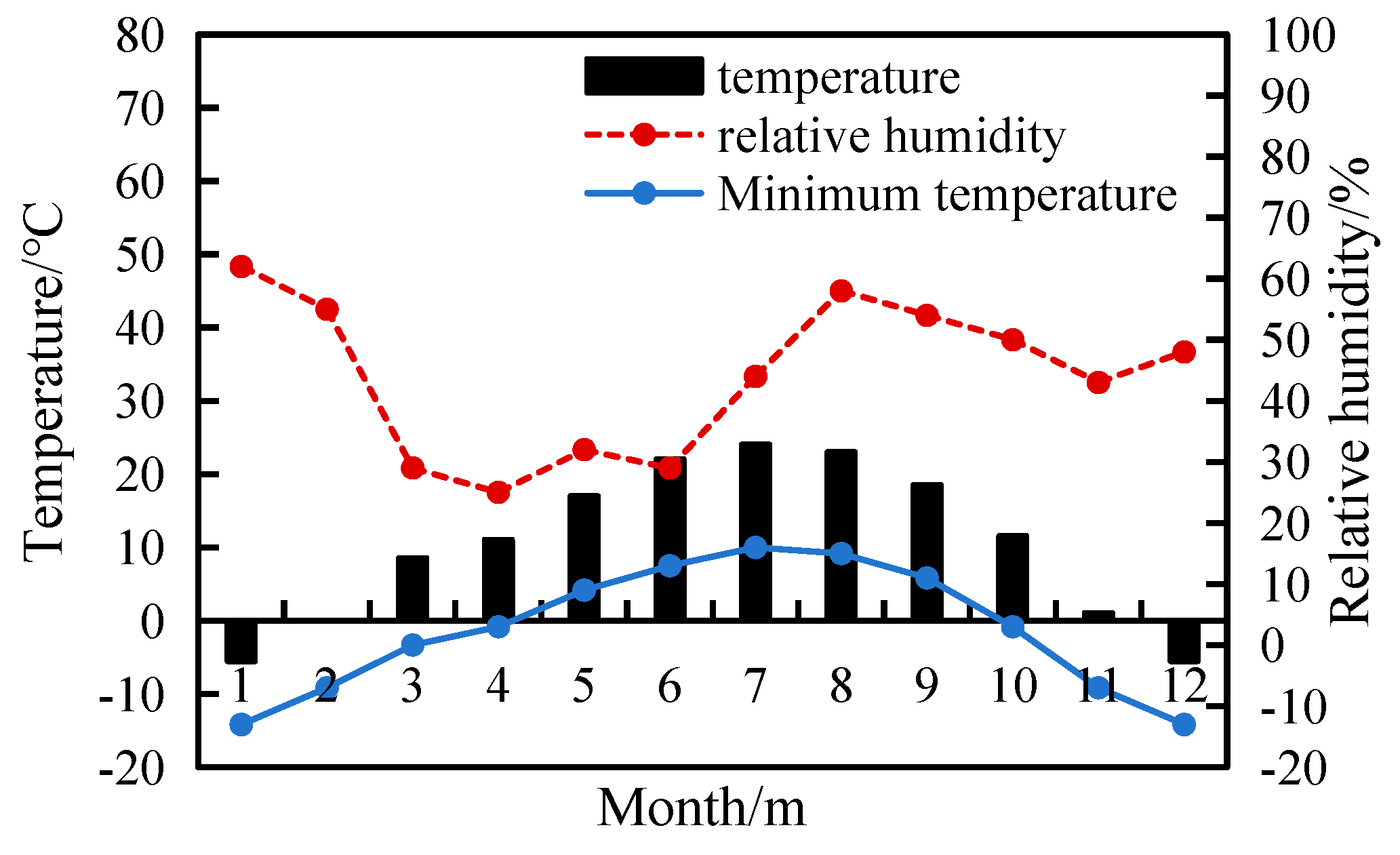


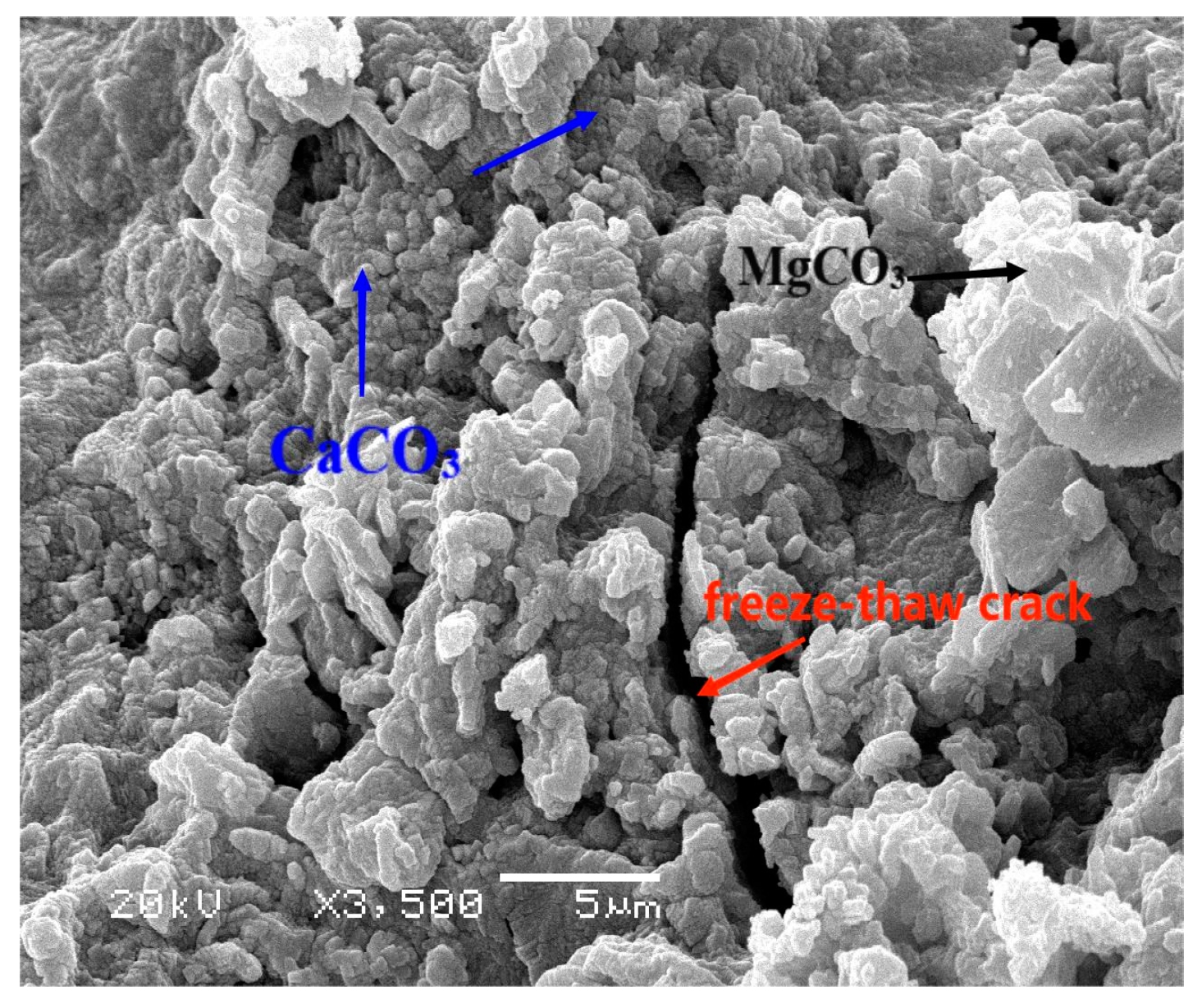


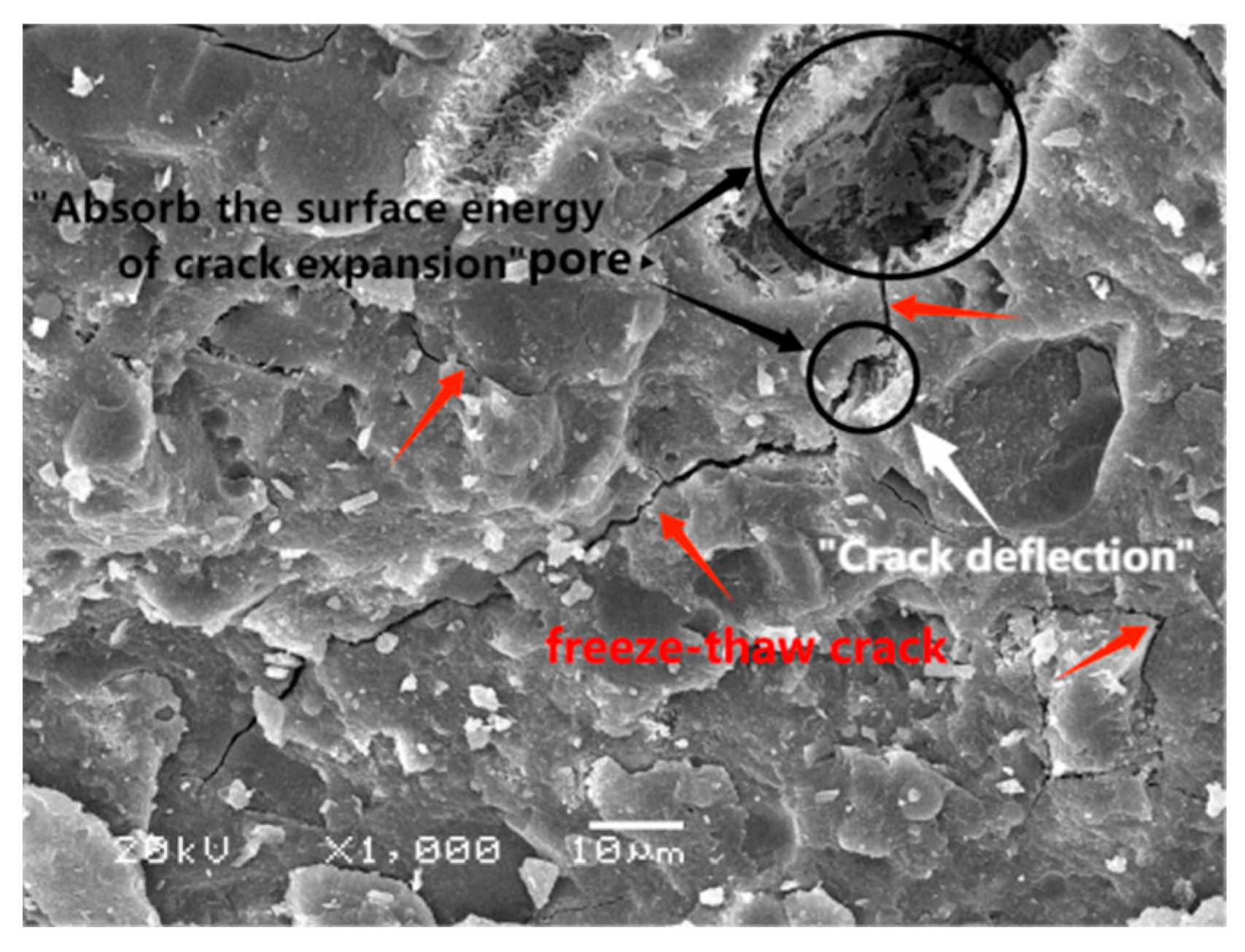
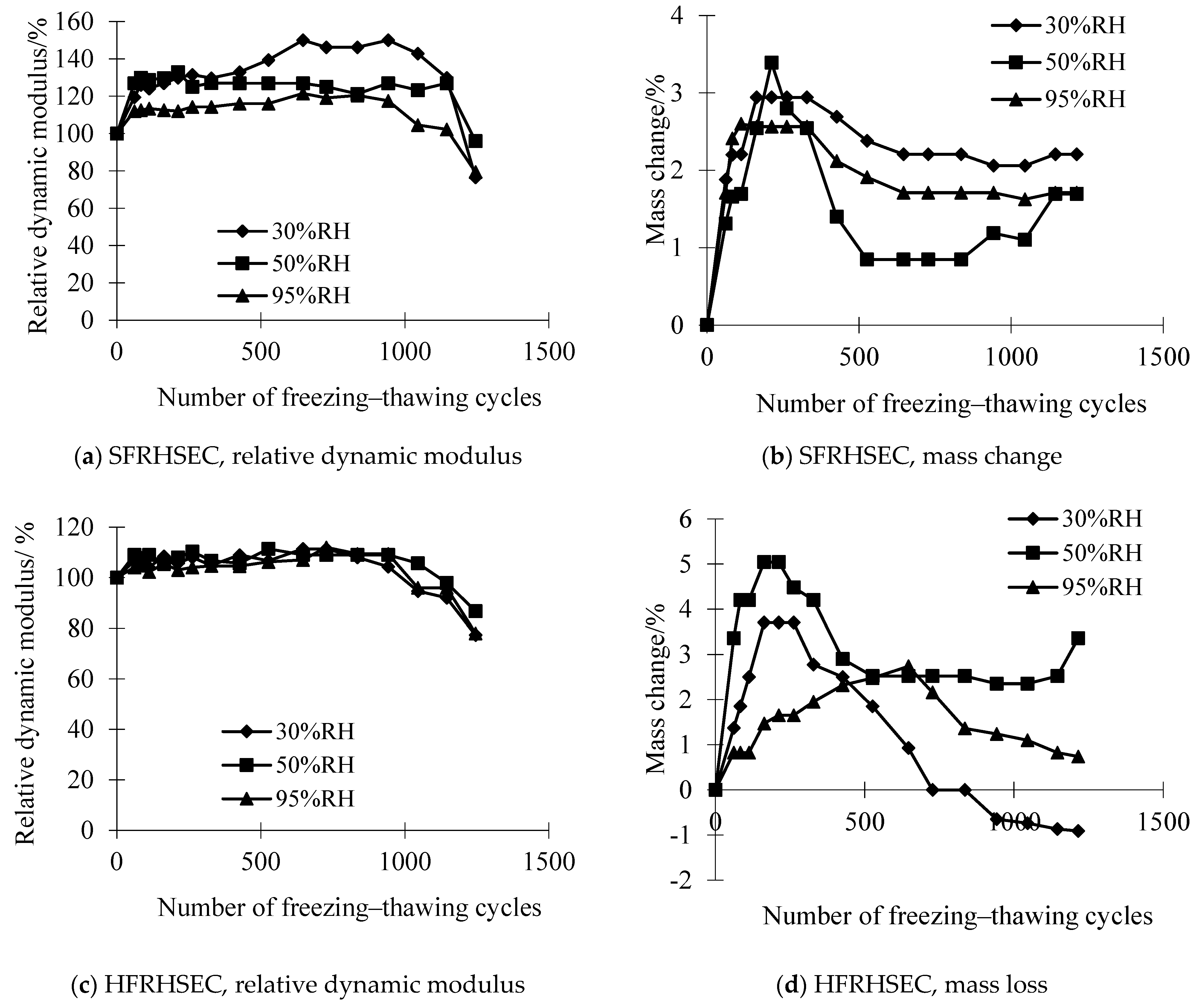


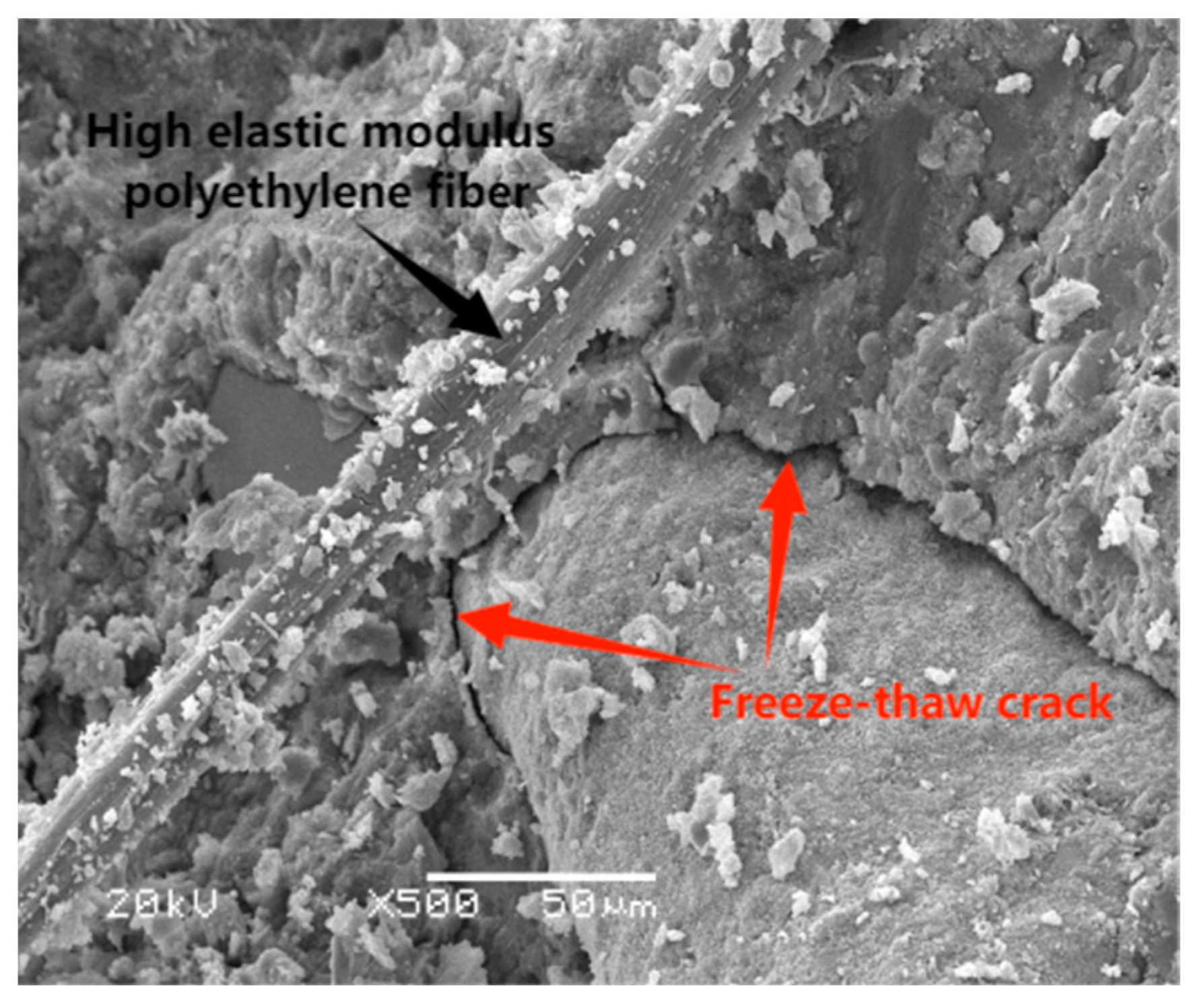
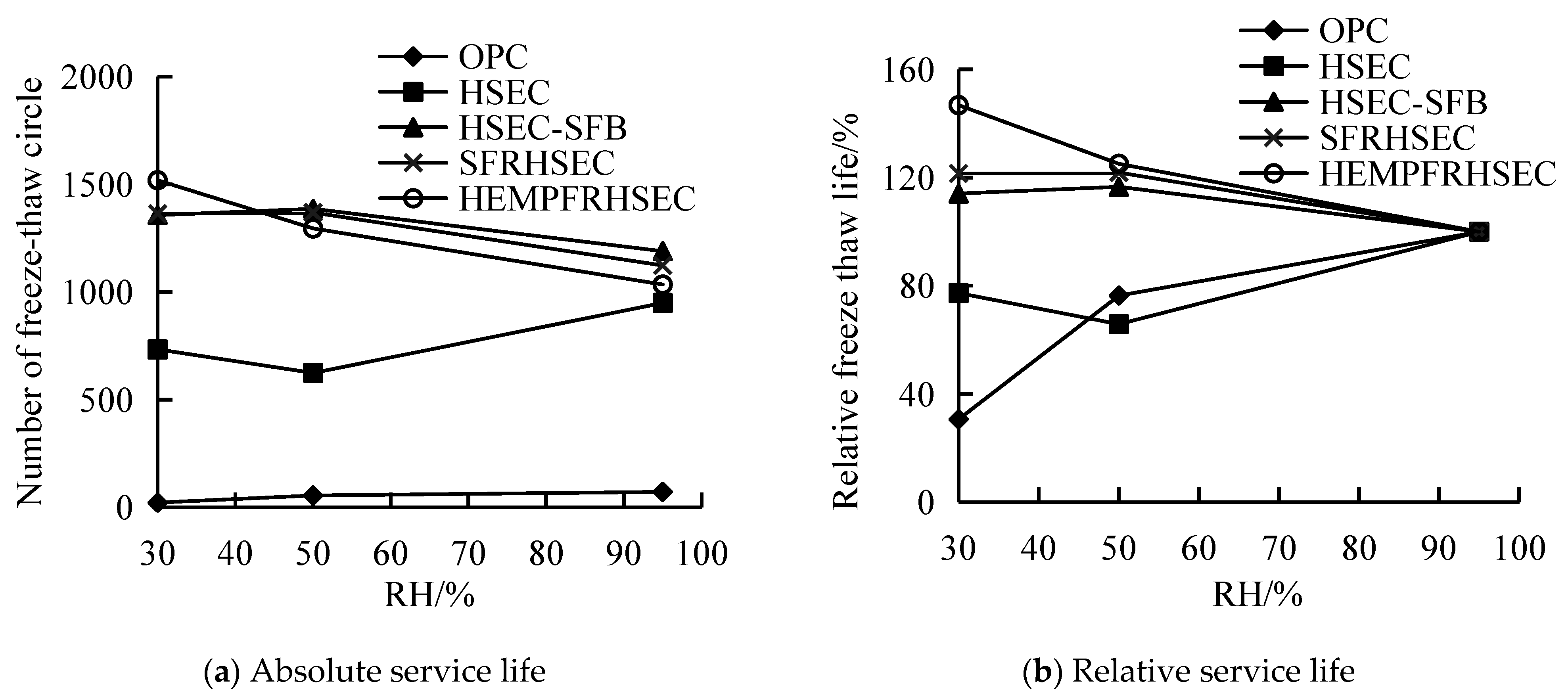
| Sample | SiO2 | Al2O3 | CaO | MgO | SO3 | Fe2O3 | MnO | TiO2 | Na2O | K2O | I.O.L. |
|---|---|---|---|---|---|---|---|---|---|---|---|
| Cement | 20.60 | 5.03 | 65.06 | 0.55 | 2.24 | 4.38 | -- | -- | -- | -- | 1.30 |
| SF | 85.16 | 0.06 | 0.56 | 2.10 | -- | 0.75 | -- | -- | -- | -- | 2.68 |
| FA | 58.30 | 20.97 | 5.16 | 1.46 | 0.81 | 7.04 | -- | -- | -- | -- | 2.64 |
| BFS | 34.20 | 14.2 | 41.70 | 6.70 | 1.00 | 0.43 | 0.30 | 1.07 | 1.27 | 0.56 | 1.70 |
| AEA | 19.82 | 16.62 | 28.60 | 1.58 | 26.86 | 2.66 | -- | -- | 0.32 | 0.30 | 3.02 |
| OPC | HSEC | HSEC-SFB | SFRHSEC | HFRHSEC | |
|---|---|---|---|---|---|
| Cement (kg·m−3) | 325 | 540 (90%) | 270 (45%) | 270 (45%) | 270 (45%) |
| Silica fume (kg·m−3) | 0 | 0 | 54 (9%) | 54 (9%) | 54 (9%) |
| Fly ash (kg·m−3) | 0 | 0 | 108 (18%) | 108 (18%) | 108 (18%) |
| blast furnace Slag (kg·m−3) | 0 | 0 | 108 (18%) | 108 (18%) | 108 (18%) |
| AEA (kg·m−3) | 0 | 60 (10%) | 60 (10%) | 60 (10%) | 60 (10%) |
| Fine aggregate (kg·m−3) | 647 | 610 | 610 | 785 | 785 |
| Coarse aggregate (kg·m−3) | 1150 | 1134 | 1134 | 957 | 957 |
| Water (kg·m−3) | 195 | 150 | 172 | 172 | 172 |
| HRWR (kg·m−3) | 0 | 3.9 | 3.9 | 5.0 | 6.5 |
| Steel fiber (kg·m−3) | 0 | 0 | 0 | 156 | 0 |
| HEMPF (kg·m−3) | 0 | 0 | 0 | 0 | 1 |
| Slump (mm) | 45 | 45 | 45 | 35 | 45 |
| Air content (%) | 1.4 | 1.8 | 2.0 | 2.1 | 3.0 |
| W/B | 0.6 | 0.25 | 0.28 | 0.28 | 0.28 |
| 180 d flexural strength (MPa) | 8.06 | 14.85 | 13.06 | 24.51 | 10.57 |
| Na+ (mg·L−1) | Mg2+ (mg·L−1) | K+ (mg·L−1) | Ca2+ (mg·L−1) | Cl− (mg·L−1) | SO42− (mg·L−1) | CO32− (mg·L−1) | HCO3− (mg·L−1) | pH |
|---|---|---|---|---|---|---|---|---|
| 97,167.92 | 3671.00 | 2638.42 | 129.29 | 107,790.00 | 36,445.42 | 25,382.08 | 4595.42 | 10 |
Disclaimer/Publisher’s Note: The statements, opinions and data contained in all publications are solely those of the individual author(s) and contributor(s) and not of MDPI and/or the editor(s). MDPI and/or the editor(s) disclaim responsibility for any injury to people or property resulting from any ideas, methods, instructions or products referred to in the content. |
© 2024 by the authors. Licensee MDPI, Basel, Switzerland. This article is an open access article distributed under the terms and conditions of the Creative Commons Attribution (CC BY) license (https://creativecommons.org/licenses/by/4.0/).
Share and Cite
Song, S.; Yu, H.; Ma, H. Influence of Drying Conditions on the Durability of Concrete Subjected to the Combined Action of Chemical Attack and Freeze–Thaw Cycles. Materials 2024, 17, 1131. https://doi.org/10.3390/ma17051131
Song S, Yu H, Ma H. Influence of Drying Conditions on the Durability of Concrete Subjected to the Combined Action of Chemical Attack and Freeze–Thaw Cycles. Materials. 2024; 17(5):1131. https://doi.org/10.3390/ma17051131
Chicago/Turabian StyleSong, Shanshan, Hongfa Yu, and Haiyan Ma. 2024. "Influence of Drying Conditions on the Durability of Concrete Subjected to the Combined Action of Chemical Attack and Freeze–Thaw Cycles" Materials 17, no. 5: 1131. https://doi.org/10.3390/ma17051131





